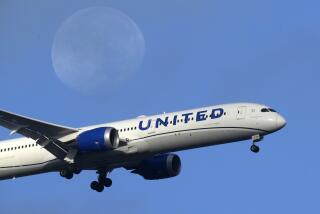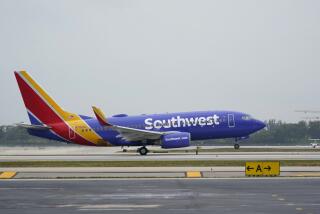Asiana jet was well below its target speed before crash, NTSB says
SAN FRANCISCO -- Asiana Flight 214 was flying significantly below its target speed and was “approaching a stall” moments before it crash landed at San Francisco International Airport, a federal official said Sunday.
The flight data recorder indicated “throttles at idle and airspeed slowed below the target airspeed” of 137 knots, said Deborah Hersman, chairwoman of the National Transportation Safety Board.
Hersman said data from the plane’s onboard recording device indicated that the aircraft was approaching a stall. She said there was a call to the crew to increase speed seven seconds before impact.
“The throttles were advanced a few seconds prior to impact, and the engines appeared to respond normally,” she said.
Moments later, the Boeing 777 jetliner’s tail hit a sea wall separating the runway from San Francisco Bay before slamming into the runway, killing two and injuring dozens of others.
Asked whether pilot error may been a factor, Hersman said, “Everything is on table right now. Nothing has been ruled out. We will not speculate and will not draw conclusions” until more is known.
There was no discussion before impact of any anomalies or problems with the aircraft’s approach to the airport, Hersman said. The plane had been cleared for visual approach -- meaning it could be landed manually -- and the aircraft was configured for landing, with its flaps at 30 degrees and gear down, she said.
Speaking at a news conference in Seoul earlier Sunday, Yoon Young-doo, Asiana’s president, described the pilots involved as “skilled” and said it could take time to determine what went wrong.
The twin-engine 777 is one of the world’s most popular long-distance planes, often used for flights of at least a dozen hours.
By Saturday night, all 307 on board the Asiana flight had been accounted for, authorities said. A total of 182 people had been transported to hospitals, including 49 in serious condition. Among the passengers were 77 Korean citizens, 141 Chinese, 61 Americans and one Japanese, according to South Korea-based Asiana.
The two passengers who died were 16-year-old students from China. Asiana Flight 214 originated in Shanghai and stopped in Seoul before flying to San Francisco.
The bodies of the teens were found on the runway, said San Francisco Fire Chief Joanne Hayes-White. It was not clear whether they had been pulled from the plane or ejected.
Hospital officials said Sunday afternoon that the crash had left at least two people paralyzed with spinal injuries. Eight people remained in critical condition.
Of the 53 patients treated at San Francisco General Hospital, 34 have been discharged and 19 remained hospitalized, hospital spokeswoman Rachael Kagan said. Six of them, including one minor girl, were in critical condition, she said.
Stanford Hospital said Sunday that it treated 55 patients from the Asiana crash, admitting 11 of them. Two of those patients were listed in critical condition at about noon Sunday.
An additional seven patients were taken to Packard Children’s Hospital at Stanford, officials said, and were listed in good condition Sunday.
Thousands of passengers were stranded at San Francisco International Airport after Saturday’s crash which shut down the airport’s four runways. SFO’s restaurants stayed open all night Saturday to cater to stranded travelers whose stood for hours in long lines to rebook their tickets.
Two runways reopened about three hours after the crash. Some international flights began leaving again Saturday night.
Around 1 p.m. Sunday, a third runway, known as 28R, reopened, officials said on Twitter.
“Some good news!” @FlySFO tweeted. “28R is now open!”
ALSO:
A frantic call from scene of S.F. crash: ‘We’re missing three.’
Plane crash: More flight cancellations, delays between L.A., S.F.
Airport equipment was out of service when plane crashed in S.F.
More to Read
Sign up for Essential California
The most important California stories and recommendations in your inbox every morning.
You may occasionally receive promotional content from the Los Angeles Times.












